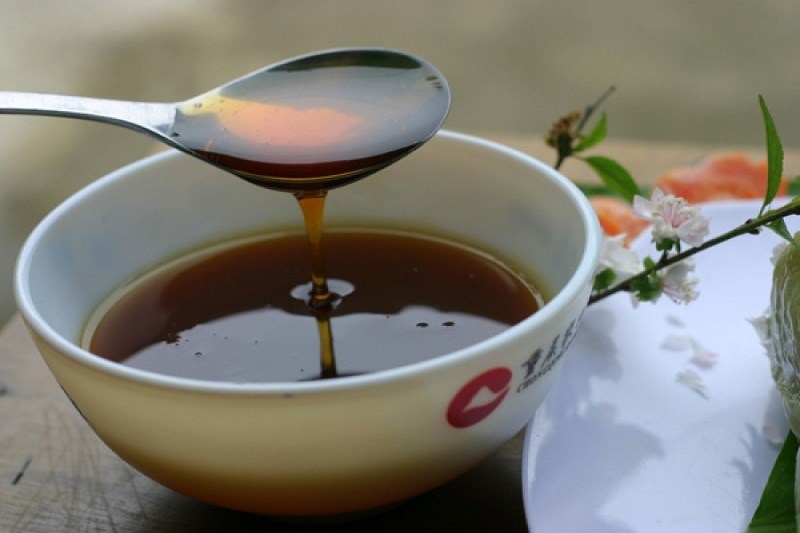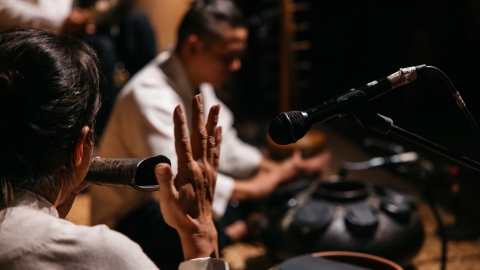Suddenly I miss the path along the dike where I used to jog every morning on my way home. I miss the early morning sunlight that casts my shadow 5, 6 meters long. I miss the morning mist lingering behind the treetops at the foot of the Rang Hac mountain range. And I miss the clear, enjoyable, and satisfying sound that can never be found in the city: the sound of fish splashing under the withered lotus stems, waiting for the brilliant summer...
In the past, only during Tet did we have banh chung and banh mat. Now, they are available all year round. If you want to eat banh mat, you can stop by a shop selling local products. I remember that in the middle of winter, when there was no drizzling or windy weather, my mother would go to the garden to choose dried banana leaves, cut out whole, wide, square pieces, layer them on top of each other, and tie them with banana leaves to wait until Tet to use to wrap banh mat.

Newly wrapped rice cake
This dried banana leaf must be a newly wilted leaf, not too fresh but not too wilted that it will be brittle and break the cake. The molasses cake is made from sticky rice flour, sweetened with molasses. I remember when making the cake, the molasses is boiled just enough, my mother toasts a few crushed gingers and sprinkles them into the boiling molasses pot. The smell of the molasses in the boiling pot blends with the smell of the grilled ginger, warming the whole house, warming the whole winter, bringing the smell of fullness, warmth and joy of Tet and Spring. The cake leaves were cleaned by my mother, the mixture of sticky rice flour and molasses sprinkled with ginger, then left to cool, spread on a small piece of cake leaf, wrapped to hold the mold, then wrapped the main leaf outside, wrapped in a square, and placed in the pot to boil.
Honey cake is a “side dish” that is not necessarily included like Tet banh chung. After boiling, the cakes are usually tied with bamboo strips dyed pink to create a Tet look, each tie of 5 pieces represents the five elements to worship ancestors or to share and eat gradually until the second of January. There is another type of cake similar to honey cake, called gai cake, which is different from honey cake in that it is mixed with gai leaves (now I can’t remember what kind of leaves they are). I remember one year someone gave me a bunch of gai leaves wrapped in dried banana leaves, my mother kept them for Tet to mix with the cakes for me, but when she opened them, the leaves were moldy, so she had to throw them away. The past was very poor, very loving, but also very warm.

Molasses is a syrupy liquid similar to honey, obtained from sugarcane.
Speaking of molasses, molasses is pressed from sugarcane, probably nowhere like in the Northern region of Vietnam, at that time there was no cement like now, molasses was used as a construction material with the same role as cement: mixed with sand and gravel to form a very viscous mortar (fresh concrete) used to build drainage pipes, cast flour mills. Admittedly, in the past there were not many tools, not as convenient as now, so the ancients did everything carefully, produced everything well, also solid. Just look at the square culverts installed at the foot of the "water-leading" canals, neatly and firmly, the sweet sand and gravel mixed with molasses formed a solid, solid block the color of tree bark or cockroach wings, a sledgehammer with a handle could not break it, flood water in the low-lying fields could rise high, no matter how long it was soaked, it would not penetrate, let alone leak or break.
My hometown’s Banh La is a cake made from rice, filled with meat mixed with crushed dried onions and wrapped in dong or banana leaves. It is said that there is a village that chooses a type of fragrant sticky rice (my father said that the rice is milled from chim rice, dam rice – special rice types offered to the King in the past), skillfully steams and boils it, the cake is taken out, peeled off and beaten against a round wooden pole in the middle of the house without breaking or falling – it is truly extremely sticky.

Inside the honey cake
Simple products from the fields and gardens are indispensable in death anniversaries or on the Tet meal tray. Simple but fragrant like water from a well in the countryside. I remember when I was a student, a friend asked: "Why is your hometown so strange? Tet is the only occasion of the year, but the banh chung is also wrapped in bone?"
Actually, if you boil the pork bones all day, they will melt and soften, making them less greasy and sweeter, increasing calcium for the body. Besides, back then, when we were poor, we couldn't find much meat. Meat could be used to make ham, to make jelly, and the remaining bones could be used to make cakes.
Same goes for Banh la, Thanh village cakes look like Banh te, Banh rang bua but are more genuine and rustic, now with plenty of wine and meat sometimes they are popular and become specialties.
If you look closely, the ingredients of the cake are also very interesting. The cake is made from rice flour (Earth element), the filling is pork (Water element) mixed with crushed onion (Metal element) and pepper (Fire element), wrapped in dong leaves (Wood element). Full of the Five Elements of mutual generation and mutual inhibition. Simple, close, easy to make and easy to eat, not a delicacy but delicious, environmentally friendly.

The smell of sticky rice flour sweetened with molasses, cooled and grilled on a charcoal stove, mixed with the familiar smell of banana leaves
The ancients were truly knowledgeable!
Today I texted and talked to you, asking if you have wrapped banh la in your hometown? Knowing that you are far away from home in the coastal land and miss your hometown Thanh Minh on Thanh Minh day - the typical season of the year for cakes. Sitting and watching the lotus pond in late Spring and early Summer, there is still a light rain in the air, looking at the pot of banh la and watching the smoke rising from the fields, missing your poor hometown, missing your old friends...



































